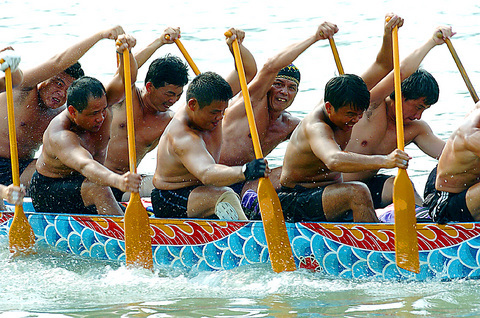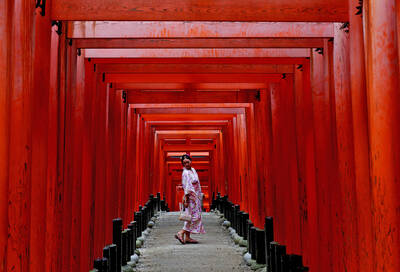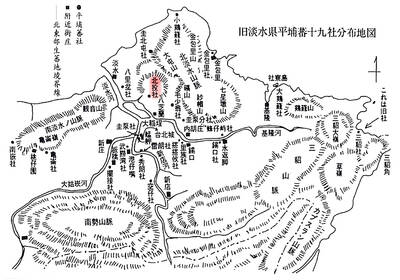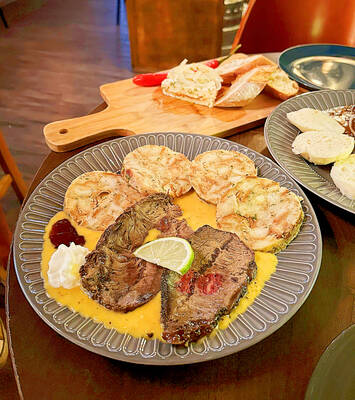The hugely popular annual dragon boat races will be the focus of a series of festivities nationwide this weekend, when hundreds of teams from across the country and a dozen international squads take to rivers in the Taipei, Bitan, Kaohsiung, Tainan, Ilan and Lukang in celebration of Duanwu Festival (
Falling on the fifth day of the fifth lunar month, Duanwu, or Dragon Boat Festival as it is more commonly known in English, can be traced back over 2,000 years to the death of the poet and respected bureaucrat Chu Yuan (
Legend has it that Yuan, a trusted adviser to the Chu emperor during the Warring States period (475 BC to 221 BC), was

discredited by a group of jealous and scheming rivals. Unable to regain the emperor's favor following the accusations of corruption, Chu decided to commit suicide by drowning.
Clasping a heavy stone to his chest Chu flung himself into the raging river. News of Chu's suicide shocked the nation and upon hearing it citizens leaped into their boats in an attempt to save him. They arrived too late, however, and Chu met his end in the waters of the Milo River in Hunan Province.
The beating of drums and the splashing of oars that are now such an integral part of the dragon boat races today are meant to mimic the frantic search for Chu.

The legend may be a couple of thousand years old, but Taiwan's dragon boat races are a mere 120 years old. They have become hugely popular and if the weather remains sunny, then the combined attendance figures for the nation's half dozen races is expected to number well into the hundreds of thousands.
This year over 500 teams will participate, both for fun and competitively. Smallscale races will be held in Ilan and Lukang and larger races will take place in Kaohsiung and Tainan.
A total of 88 teams will be competing in Kaohsiung and pitting their strength against each other on the Love River (

While The races outside of Taipei promise to be entertaining and competitive affairs, it is the Taipei City Government sponsored President's Cup that is once again expected to draw the largest crowds and the lion's, or rather the dragon's share of media attention.
Organized by the Education Department of Taipei City Government (
This year over 2,000 individuals representing a total of 111 teams will be competing in the Taipei City Government sponsored event. The first round of races will take place from 8am until early afternoon today. On Saturday races will again begin at 8am and will continue until 6pm and on Sunday those teams still in with a chance to raise the Presidents Cup will race from 8am until early afternoon.

Divided into two categories -- competitive and civil -- and subdivided into over a dozen small divisions, the President's Cup attracts a good mix of both competitive and less competitive teams. Each team, regardless of its will or ability to win, comprises 18 rowers, one coxswain and a drummer.
The largest and most cutthroat division is the Men's Open. Featuring top international teams from the US, the Philippines, Japan, Nepal and Hong Kong as well as Taiwan's top seeded competitors -- the Taipei Physical Education College (
Not all of the teams take it quite a seriously as those from the two highly competitive institutes of higher learning and the semi-pros from overseas. For John Nixon and his Taipei European School team participating in the annual event is more important than winning.

PHOTOS: TAIPEI TIMES
"I think what's nice is the mixture of staff, parents and older kids who make up the team," Nixon said. "We do take it seriously and we do like to win, but it's the taking part that is really more important than anything else."
Regardless of where the race's more serious contenders hail from, many have been preparing for the occasion for quite sometime.
"We started practicing twice a week in mid-April. I'd say that this year we are more focused in our will to win. We've put our maximum into it and the intensity is much higher," said Jim Stokes of the Canadian Society dragon boat team. "The key is coordination and we'll try to stick with the pace of the drummer and go with the beat of the drums."
Competitors unlucky enough to fall into the water are unlikely to drown as organizers always ensure that there are plenty of safety boats in and around the race areas, but as the Keelung River is not known for its cleanliness racers have been advised to take care.
Should a rower find him or herself in the drink medical staff will be on hand to assist. Rowers with open wounds or burst blisters are encouraged to seek medical treatment as soon as they reach dry land to ensure that wounds do not become infected.
While the 111 teams competing in Taipei have been made aware of the health hazards of the Keelung River, few have taken the same extreme precautions as those employed by the Taipei American School team.
Coached by Australian Peter Clark, whose guidance helped Nathan Baggaley secure two silver medals for the Australian Olympic kayaking team in Athens last year, the team has taken the seemingly strange precaution of learning to paddle without splashing.
"We're all aware of the state of the river and we've seen dead rats float past. The water isn't [clean] and you don't want to get any on yourself or on your teammates," Clark said. "The team had to learn to paddle without splashing. It's not a [method] I would have chosen to teach the team, but it has enabled us to become technically correct and I think it will work in our favor."
Those teams competing in Taipei County's Congressional Cup (
Wherever you choose to attend, the annual Dragon Boat Festival is more than just a day at the races for the hundreds of participants and thousands of spectators. It's a chance to eat, drink and make merry along the banks of some of Taiwan's most picturesque and several of its not so charming rivers.
Along with cheering for favorite teams, as they pit their rowing prowess against the currents, the pollution and the wind, visitors will be treated to performances by local musical acts and theatrical groups. And, as with any Chinese festival, food is an integral part of the day out at the dragon boat races.
Dozens of food stalls will be on hand and selling everything from the traditional zongzi (

Seven hundred job applications. One interview. Marco Mascaro arrived in Taiwan last year with a PhD in engineering physics and years of experience at a European research center. He thought his Gold Card would guarantee him a foothold in Taiwan’s job market. “It’s marketed as if Taiwan really needs you,” the 33-year-old Italian says. “The reality is that companies here don’t really need us.” The Employment Gold Card was designed to fix Taiwan’s labor shortage by offering foreign professionals a combined resident visa and open work permit valid for three years. But for many, like Mascaro, the welcome mat ends at the door. A

The Western media once again enthusiastically forwarded Beijing’s talking points on Japanese Prime Minister Sanae Takaichi’s comment two weeks ago that an attack by the People’s Republic of China (PRC) on Taiwan was an existential threat to Japan and would trigger Japanese military intervention in defense of Taiwan. The predictable reach for clickbait meant that a string of teachable moments was lost, “like tears in the rain.” Again. The Economist led the way, assigning the blame to the victim. “Takaichi Sanae was bound to rile China sooner rather than later,” the magazine asserted. It then explained: “Japan’s new prime minister is

NOV. 24 to NOV. 30 It wasn’t famine, disaster or war that drove the people of Soansai to flee their homeland, but a blanket-stealing demon. At least that’s how Poan Yu-pie (潘有秘), a resident of the Indigenous settlement of Kipatauw in what is today Taipei’s Beitou District (北投), told it to Japanese anthropologist Kanori Ino in 1897. Unable to sleep out of fear, the villagers built a raft large enough to fit everyone and set sail. They drifted for days before arriving at what is now Shenao Port (深奧) on Taiwan’s north coast,

Divadlo feels like your warm neighborhood slice of home — even if you’ve only ever spent a few days in Prague, like myself. A projector is screening retro animations by Czech director Karel Zeman, the shelves are lined with books and vinyl, and the owner will sit with you to share stories over a glass of pear brandy. The food is also fantastic, not just a new cultural experience but filled with nostalgia, recipes from home and laden with soul-warming carbs, perfect as the weather turns chilly. A Prague native, Kaio Picha has been in Taipei for 13 years and